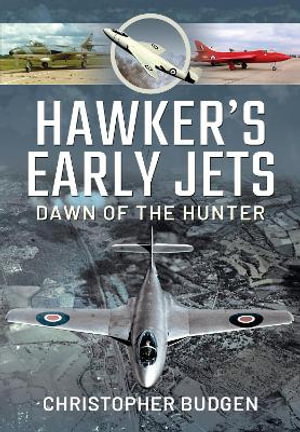
PublishedAir World, March 2022 |
ISBN9781526792174 |
FormatHardcover, 296 pages |
Dimensions24.6cm × 17.2cm |
On 2 September 1947, Hawker Aircraft Ltd figuratively and literally took to the air with their first jet design, the P.1040. Conceived in the latter days of the Second World War, and developed in the straitened times of post-war austerity, the aircraft allowed Hawker to explore the new technology before moving on to more ambitious programmes.
Rejected by the Royal Air Force, subsequent development of the aircraft allowed the Royal Navy to find in it a useful role at sea. As this project slowly wound its way through the government bureaucracy against a background of national insolvency, Hawker continued their research into more potent forms of jet travel with their first swept wing aircraft, the P.1052, their first rocket powered example, the P.1072, and, finally, the sleek, all swept P.1081. These essentially research aircraft gave the company the experience and expertise it required to produce a powerful, transonic fighter with which to equip the RAF for the defence of the UK and other friendly nations at a time when the Cold War threatened to engulf the world in a truly global nuclear conflict. That aircraft, the P.1067 Hunter first flew in 1951 and was, at the time, the fastest fighter in the world as evinced by gaining the World Airspeed Record in 1953 prior to entry into RAF service; at a stroke revolutionising the potential of the UK's air arm. Such was the haste with which this occurred that many teething problems remained to be resolved, as detailed here, but eventually the aircraft would become the day fighter of choice for many of the world's air forces and remain in service for decades to come. AUTHOR: Christopher Budgen, growing up in the shadow of Hawker's Flight Test Centre at Dunsfold in Surrey, entered employment there in the 1970s, shortly after the nationalisation of the aircraft industry and the company's amalgamation into state-owned British Aerospace. During 21 years with BAe, as well as working on many Hawk, Harrier and Sea Harrier projects, he was also fortunate to be involved with Hawker's superlative Hunter in the guise of a modified T.8M used in the development of the Sea Harrier for aircrew training. Chris's previous book detailing Hawker history -'Hawker's Secret Cold War Airfield' -is now followed by this work. As an archivist for some years engaged at Brooklands Museum and specialising in Hawker Aircraft Ltd and successor companies, Chris is well-placed to bring to light the previously unrecorded detail of Hawker's fascinating history. 100 b/w illustrations

